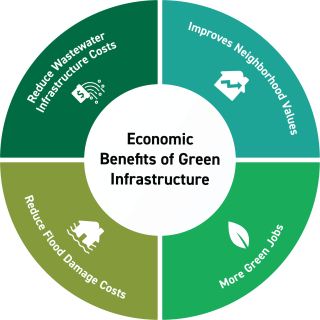Economic Benefits of Green Infrastructure

Reduce Wastewater Infrastructure Costs. Green infrastructure that increases infiltration or reuses captured water on site can lead to cost savings in communities with combined sewer systems. Reducing the amount of stormwater entering combined sewer systems decreases the volume of stormwater that must be treated at a wastewater treatment facility. Reducing runoff volumes with green infrastructure can also reduce the amount and size of piped infrastructure needed to convey stormwater to a wastewater treatment facility in a combined sewer system.
Improves Neighborhood Values. Open green space, parks, vegetation, and landscaping provide environmental and social benefits to residents and help create neighborhoods that are desirable places to live. Using green infrastructure creates attractive and resilient neighborhoods, which in turn can increase nearby property values. A study by the University of Wisconsin–Milwaukee Center for Economic Development indicates that “a recreational rooftop garden increased property values by about 11 percent.”1 Other studies have shown that green infrastructure did not directly increase property values.2
EPA resources:
Other resources:
- The Center for Neighborhood Technology, Green Stormwater Infrastructure: Impact on Property Values (pdf)
- Natural Resources Defense Council, The Green Edge: How Commercial Property Investment in Green Infrastructure Creates Value (pdf)
- EPA Study on Property Values in Omaha, NE
More Green Jobs. Green infrastructure design, installation, and maintenance activities support jobs and career opportunities for people with all levels of education and work experience. For example, 52 percent of green infrastructure workers in Pennsylvania earn more than $31,200 annually (i.e., $15 per hour), even without a high school diploma or equivalent.3 The potential for green infrastructure job growth is substantial, especially when stormwater requirements and funding sources are in place. From 2011 to 2019, Pennsylvania’s green infrastructure jobs grew by 9.2 percent, and during that same time, Pennsylvania had 6.3 percent growth across all occupations statewide.4
EPA resources:
Other resources:
- Green for All, American Rivers, Staying Green and Growing Jobs: Green Infrastructure Operations and Maintenance as Career Pathway Stepping Stones (pdf)
Reduce Flood Damage Costs. Green infrastructure can lessen the impacts of flood damage to properties and infrastructure. Localized flooding (due to overwhelmed drainage systems during heavy rainfall) and riverine flooding (river flows exceeding the capacity of the river channel) may both become more frequent and intense in some communities. In areas impacted by localized flooding, green infrastructure can be used to absorb stormwater and reduce surface flow, pooling, and seepage, all of which can cause property damage. In areas impacted by riverine flooding, green infrastructure, open space preservation, and floodplain management can complement gray infrastructure approaches and reduce the extent of flood damage from channel overflows.
EPA resources:
Other resources:
1 Madison, C. (2013). Impact of green infrastructure on property values within the Milwaukee Metropolitan Sewerage District Planning Area. Center for Economic Development Publications, 16.
2 Hoover, F.A., J.I. Price, M.E. Hopton (2020). Examining the effects of green infrastructure on residential sales prices in Omaha, Nebraska.
3 Sustainable Business Network (2021). Green Stormwater Infrastructure (GSI): A Tool for Economic Recovery and Growth in Pennsylvania (pdf).
4 Sustainable Business Network (2021). Green Stormwater Infrastructure (GSI): A Tool for Economic Recovery and Growth in Pennsylvania (pdf).
